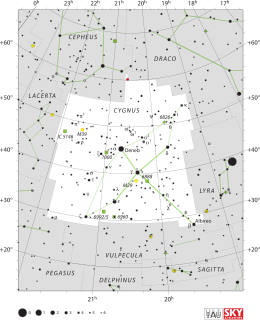Phi Cygni
| Phi Cygni | |
|---|---|
| Classe spettrale | K0III + K0III[2] |
| Distanza dal Sole | 266 ± 5 anni luce (81,6 ± 1,5 pc) |
| Costellazione | Cigno |
| Coordinate | |
| (all'epoca J2000.0) | |
| Ascensione retta | 19h 39m 22.60591s[1] |
| Declinazione | 30° 09′ 11.9604″[1] |
| Parametri orbitali | |
| Semiasse maggiore | 26,9 mas[2] |
| Inclinazione orbitale | 80,8[2] |
| Eccentricità | 0,5557[3] |
| Dati fisici | |
| Raggio medio | A: 8,9[3] |
| Massa | |
| Velocità di rotazione | A: 4,7 km/s[3] |
| Temperatura superficiale | |
| Luminosità | |
| Indice di colore (B-V) | +0.98 (B-V)[5] +0.81 (U-B)[5] |
| Metallicità | −0,11 [Fe/H][3] |
| Età stimata | 0,65 Ga[6] |
| Dati osservativi | |
| Magnitudine app. | 4.70[5] (5.31 + 5.6)[2] |
| Magnitudine ass. | +0.12[7] (+0.77/+1.07)[8] |
| Parallasse | 12,25±0,24 mas[1] |
| Moto proprio | AR: +2.48 mas/anno Dec: +36.50 mas/anno[1] |
| Velocità radiale | +4,50 km/s[9] |
| Nomenclature alternative | |
Phi Cygni, latinizzato da φ Cygni, è una stella binaria[10] sita nella costellazione settentrionale del Cigno. È debolmente visibile a occhio nudo con una magnitudine visiva apparente di 4,70[5]. La parallasse annua è di 12,25 mas[1] misurata dalla Terra, che fornisce una stima della distanza di circa 266 al. Si sta allontanando ulteriormente dal Sole con una velocità radiale di +4,5 km/s[9].
Caratteristiche[modifica | modifica wikitesto]
φ Cygni è un sistema binario spettroscopico a doppia linea, il che significa che le linee di assorbimento di entrambi i componenti sono visibili nello spettro. I due insiemi di linee spettrali sono quasi identici e ad entrambe le stelle viene assegnato un tipo spettrale di K0III, corrispondente alle stelle giganti evolute. Sono considerate giganti red clump, stelle che hanno iniziato la fusione dell'elio centrale e giacciono sul ramo orizzontale del diagramma H-R, ma a causa della loro metallicità e delle dimensioni del loro involucro di idrogeno si trovano molto vicino al ramo delle giganti rosse[4][11]. Si presume che le due stelle abbiano la stessa età, che sarebbe di circa 650 milioni di anni[6][8]. La coppia ha un periodo orbitale di 434,208 giorni, o 1,2 anni terrestri, un semiasse maggiore di 26,9 mas e un'alta eccentricità di 0,56[3].
Note[modifica | modifica wikitesto]
- ^ a b c d e van Leeuwen, F. (2007). "Validation of the new Hipparcos reduction". Astronomy and Astrophysics. 474 (2): 653–664. arXiv:0708.1752. Bibcode:2007A&A...474..653V. doi:10.1051/0004-6361:20078357.
- ^ a b c d Pourbaix D, Resolved double-lined spectroscopic binaries: A neglected source of hypothesis-free parallaxes and stellar masses, in Astronomy and Astrophysics Supplement, vol. 145, 2ª ed., 2000, p. 215, Bibcode:2000A&AS..145..215P, DOI:10.1051/aas:2000237.
- ^ a b c d e f g h i j Massarotti, Alessandro; Latham, David W; Stefanik, Robert P; Fogel, Jeffrey (2008). "Rotational and Radial Velocities for a Sample of 761 HIPPARCOS Giants and the Role of Binarity". The Astronomical Journal. 135: 209. Bibcode:2008AJ....135..209M. doi:10.1088/0004-6256/135/1/209.
- ^ a b c Fekel, F. C (2004). "The Spectroscopic Orbit of φ Cygni, a System with Two Late-Type Giants". The Environment and Evolution of Double and Multiple Stars. 21: 63. Bibcode:2004RMxAC..21...63F.
- ^ a b c d Fernie, J. D. (June 1969), "UBV observations of miscellaneous stars", Journal of the Royal Astronomical Society of Canada, 63: 133–135, Bibcode:1969JRASC..63..133F.
- ^ a b Soubiran, C; Bienaymé, O; Mishenina, T. V; Kovtyukh, V. V (2008). "Vertical distribution of Galactic disk stars. IV. AMR and AVR from clump giants". Astronomy and Astrophysics. 480: 91. arXiv:0712.1370. Bibcode:2008A&A...480...91S. doi:10.1051/0004-6361:20078788.
- ^ Anderson E., Francis Ch., XHIP: An extended hipparcos compilation, in Astronomy Letters, vol. 38, 5ª ed., 2012, p. 331, Bibcode:2012AstL...38..331A, DOI:10.1134/S1063773712050015, arXiv:1108.4971.
- ^ a b Armstrong, J. T; Hummel, C. A; Quirrenbach, A; Buscher, D. F; Mozurkewich, D; Vivekanand, M; Simon, R. S; Denison, C. S; Johnston, K. J; Pan, X.-P; Shao, M; Colavita, M. M (1992). "The orbit of Phi Cygni measured with long-baseline optical interferometry - Component masses and absolute magnitudes". Astronomical Journal. 104: 2217. Bibcode:1992AJ....104.2217A. doi:10.1086/116396.
- ^ a b Pourbaix, D.; et al. (2004), "SB9: The Ninth Catalogue of Spectroscopic Binary Orbits", Astronomy & Astrophysics, 424 (2): 727–732, arXiv:astro-ph/0406573, Bibcode:2009yCat....102020P, doi:10.1051/0004-6361:20041213.
- ^ Eggleton, P. P.; Tokovinin, A. A. (September 2008), "A catalogue of multiplicity among bright stellar systems", Monthly Notices of the Royal Astronomical Society, 389 (2): 869–879, arXiv:0806.2878, Bibcode:2008MNRAS.389..869E, doi:10.1111/j.1365-2966.2008.13596.x Vizier catalog entry
- ^ Armstrong, J. T; Hummel, C. A; Quirrenbach, A; Buscher, D. F; Mozurkewich, D; Vivekanand, M; Simon, R. S; Denison, C. S; Johnston, K. J; Pan, X.-P; Shao, M; Colavita, M. M (1992). "The orbit of Phi Cygni measured with long-baseline optical interferometry - Component masses and absolute magnitudes". Astronomical Journal. 104: 2217. arXiv:1304.2530. Bibcode:1992AJ....104.2217A. doi:10.1086/116396.
